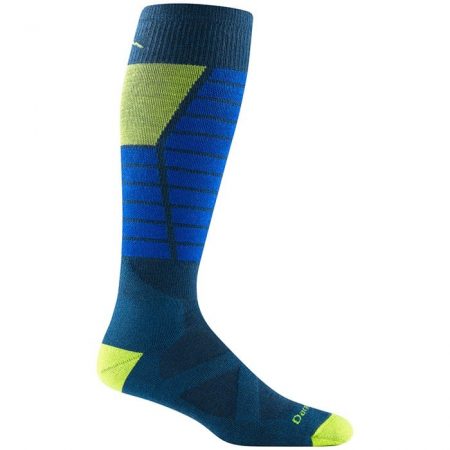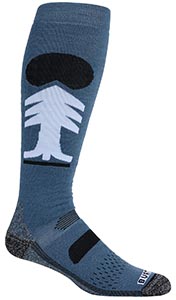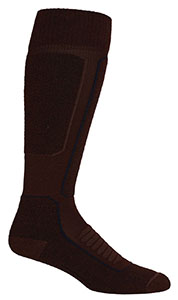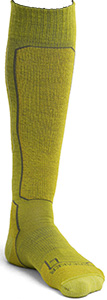
When it comes to snowboarding, your feet are pretty important: Check out our favorite pairs of snowboarding socks. Photo: Steve Andrews//The Inertia
Snowboard socks have a huge impact on your days on the slopes. Keeping your feet warm (but not too warm), dry, and comfortable is essential, and a great pair of socks is a critical part of your snowboarding kit.
We’ve tested dozens of ski and snowboard socks over the years, and there are plenty of great options on the market. Read on to learn more about the best snowboard socks of 2025.
Navigate To: Comparison Table | How We Tested | Buyer’s Guide
Related: Best Snowboard Boots | Best Snowboard Bindings
Editor’s Note: We updated this guide in March 2025 with new picks, refreshed links, and improved navigation.
The Best Snowboard Socks of 2025
Best All-Around Snowboard Socks: Darn Tough Function X Midweight
Best Budget Snowboard Socks: Evo Medium Cushion Snow Sock
Best Heavyweight Snowboard Socks: Smartwool Full Cushion
Best Cushioning: Le Bent Xavier De La Rue Pro Series
Best Spring Snowboard Socks: ThirtyTwo CoolMax
Jump to More Great Snowboard Socks
Best All-Around Snowboard Socks
Darn Tough Function X Midweight ($33)
Materials: 59% merino, 38% nylon, 3% lycra
Weight: Medium
Cushioning: Targeted
Pros: Lifetime guarantee, comfortable and responsive
Cons: Underfoot cushioning doesn’t add arch support
With so many great socks available, it was really hard to crown a winner as the best all-around. However, we kept going back to the Darn Tough Function X because it fell in the Goldilocks zone of being “just right” for a number of attributes.
The sock has just the right amount of thickness and warmth, just the right amount of cushioning, and just the right amount of wool to be warm and keep feet dry. Add in the fact that Darn Tough gives a lifetime warranty, and these socks were enough for us to pull them out of the drawer more often than not.
Best Budget Snowboard Sock
Evo Medium Cushion Snow Sock ($20)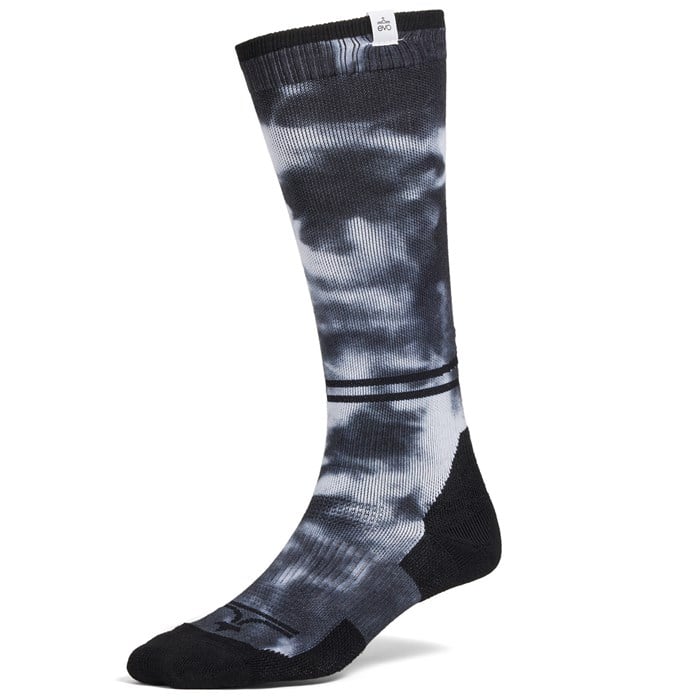
Materials: 77% Polyester, 18% Polyamide, 5% Elastane
Weight: Medium
Cushioning: Heel, toe
Pros: Solid moisture wicking and performance for price
Cons: Material blend isn’t very comfortable
The Evo Medium Cushion Snow Sock is a classic performance snow sock, featuring a moisture-wicking polyester blend, with just enough cushioning and excellent breathability. While the material isn’t quite as cozy as some of the merino options on this list, it breathed super well for the amount of cushion, and we didn’t experience excess moisture in our boots, even on warm days. At $20, you can’t really beat the performance and longevity you get with these socks from Evo—buy a few pairs and call it good for the season (especially in the spring, when they go on sale for steep discounts).
Check Price on EvoBest Heavyweight Snowboard Socks
Smartwool Full Cushion Snowboard Sock ($31)
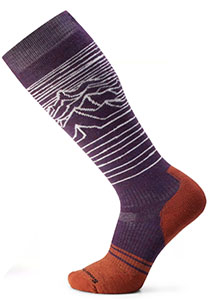
Materials: 66% merino, 32% nylon, 2% elastane
Weight: Heavy
Cushioning: Full
Pros: Warm and soft
Cons: Can get heavy when wet
Snowboarding legend Brian Iguchi helped design this sock, and that might be enough for us to believe it’s something to write positive reviews about. But after trying it on and riding with it, the feeling is what counts, so we had to give these a top nod.
A thicker sock isn’t for everyone, but those who are out in the elements all day and every day will appreciate a thicker construction. The Smartwool Full Cushion Snowboard Sock has the highest concentration of merino wool of any of the socks we tested, and while that does add to thickness, it also helps with warmth. For big days out in the backcountry, especially if you’re staying overnight, this is the sock that will stay warm through thick and thin. And speaking of thick – the added thickness helps to keep the foot and leg snug when going big. And really, in the grand scheme of things, a larger sock doesn’t add a huge amount of weight. The only exception is if it gets wet. Merino wool absorbs moisture, which keeps your feet dry, but also holds the moisture. So as long as you have decent boots that keep moisture out, you should be fine.
Best Cushioning
Le Bent Xavier De La Rue Pro Series Light Cushion ($37)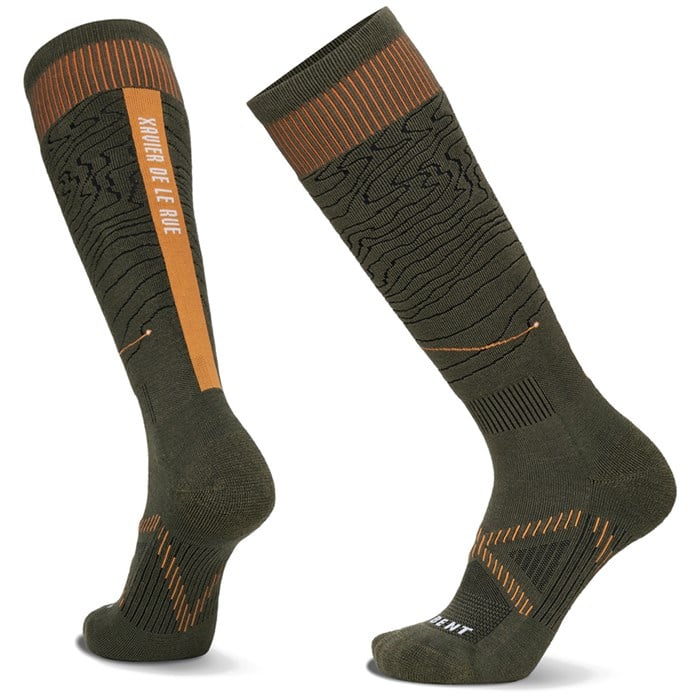
Materials: 41% Nylon, 34% Rayon from Bamboo, 23% Merino Wool, 3% Elastane
Weight: Light
Cushioning: Targeted
Pros: Best light cushioning in test, resists moisture and stink
Cons: On the pricier side
We’ve been rocking with Le Bent gear all snow season, and the Le Bent Xavier De La Rue Pro Series Light Cushion Socks are one of our favorites this year. With the best blend of targeted cushion and breathability we tested this season, the somewhat pricey socks are more than worth it. Le Bent utilizes rayon from bamboo in socks and base layers, which resists stink and provides excellent comfort and breathability from a natural fiber. These aren’t quite as moisture-wicking as pure polyester blends, but they are way more comfortable, an easy trade-off in our minds. We loved these socks in all conditions, from huge powder days to late spring slush. This is one sock that is for sure in our long-term rotation.
Check Price on EvoBest Spring Snowboard Socks
ThirtyTwo Coolmax ($21)
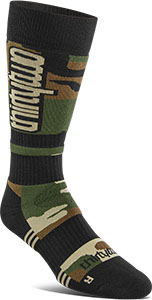
Materials: 41.5% Coolmax, 41.5% cotton, 15% nylon, 2% spandex
Weight: Medium
Cushioning: ASI – Custom integration with Thirtytwo Boots
Pros: Excellent breathability
Cons: Can feel cold when wet
We love spring days for the goggle tans, booters, and aprés patio sessions where the afternoons blend into the evenings. What we don’t like is having thick winter socks that end up being a little too much sock for the sunshine. Thirtytwo has created its own wool blend called CoolMax, which lives up to the name. It has a nice breathability to it that definitely wasn’t as insulating as other socks we tried. This is great news when the temperatures are above freezing and you’re hiking a jump to get that cover shot… or simply a really cool profile picture that will make your mother wish you stayed in college.
ThirtyTwo socks also have a custom cushioning system that works with their boots to form a solid fit in their liner, which also has a jigsaw puzzle-like array to match the socks. It’s not super noticeable, but that said, we didn’t move around as much with the socks on. So there’s that. Since it does have cotton, though, it’s at risk of getting cold when wet, which is why this is more of a spring sock than something to wear in sub-zero temps.
Check Price on AmazonMore Great Snowboard Socks
Burton Performance Midweight Sock ($32)
Materials: 53% merino, 45% nylon, 2% lycra
Weight: Medium
Cushioning: Targeted
Pros: Well-designed, unique details
Cons: Minimal shin padding
Burton knows snowboarding. Anyone who has used any of their gear over the past 40 years would likely agree. So when it comes to a performance sock catered specifically to snowboarding, it should be no surprise that they lead the charge for knowing what a snowboarder needs. With just the right amount of material in just the right places (the sock makes use of “super low-profile cushioning on the instep, shin, and calf”), you can tell that there was a lot of thought put into the design for these socks. Add in warmth and comfort, and this is a sock that can go the distance.
Are all the different cushion zones necessary? Depends on who you ask. But for people who want optimum movement in the foot and ankle, and padding where you need it, but not where you don’t, this sock is worth the few bucks extra. There isn’t much shin padding, so if that’s of importance, other socks might be a better choice, but for movement in the foot, this is one of our top picks.
Check Price on Evo Check Price on Backcountry
Icebreaker Merino Ski+ Medium ($31)
Materials: 53% merino, 45% nylon, 2% lycra
Weight: Medium
Cushioning: Targeted
Pros: Great warmth and cushioning
Cons: A tad bulky
Making products out of merino wool long before it became en vogue, Icebreaker is one of the leaders in the undergarment scene for a reason – they make quality products that work well. The brand’s Merino Ski+ (and snowboard) socks feel great from beginning to end, and the cushioning is well-placed on the shins and heel to give you a little extra padding where it’s needed most. The medium-weight sock is in the Goldilocks zone of comfort: just enough to provide ample warmth, but not so much that you can’t feel the responsiveness of the boot. It’s a great all-around choice and one where you won’t regret the purchase.
It’s important to note that their warranty has changed to one year, and you’ll need a receipt to go with it. So make sure you file the receipt away but there’s a good chance you won’t need it as these socks are built to last.
Check Price on BackcountryDarn Tough – Outer Limits ($31)

Materials: 55% nylon, 41% merino, 4% lycra
Weight: Light
Cushioning: Shins
Pros: Great body-mapped cushioning
Cons: Material feels thin underfoot
Darn Tough has been known to make a solid sock and we were pretty stoked on everything its Outer Limits had to offer all around. While it doesn’t have as high of a percentage of Merino as some other socks on this list, the blend seemed to work well enough to not have any complaints in the warmth or moisture department, meaning after a long day of riding they still felt comfortable underneath.
Another standout feature of the socks is in their guarantee – Darn Tough backs its socks for life. So if you’re the type of person to really take socks through the wringer and want a bit more of an assurance that you won’t have to keep buying new socks all the time, this is a great option. And the Outer Limits socks were some of our favorites thanks to multiple cushioning zones: extra on the bottom and shin where it’s needed most, and a medium zone in the next most prone areas, with the top of the sock being made of lighter materials for added breathability. It also provided some excellent compression, helping aid circulation, which naturally gets the feet warmer in itself.
Check Price on Evo Check Price on REI
Burton [ak] Endurance Socks ($40)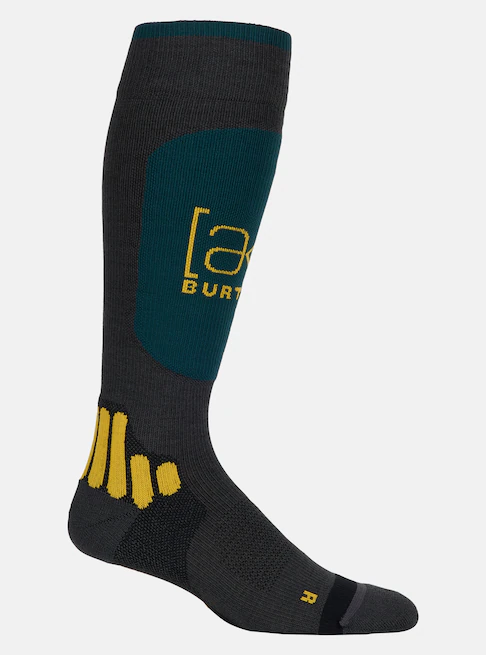
Materials: 63% Polyamide, 22% Polyester, 10% Wool, 5% Elastane
Weight: Light
Cushioning: Targeted
Pros: Stays super dry, ideal cushioining
Cons: Material blend isn’t most comfortable
From Burton’s coveted [AK] line, the Burton [ak] Endurance Socks are peak performance from snowboarding’s biggest brand. We loved the cushioning spots in these socks—perfectly dialed for all the typical hotspots in snowboarding boots (ankles, shins, underfoot). They breathe where they should and soften where they should. The blend wasn’t quite as comfy as something like the Le Bent XDLRs, but they are still up there as a top sock for hard-charging.
Check Price on BackcountryIcebreaker Ski+ Light ($29)
Materials: 55% merino, 42% nylon, 3% lycra
Weight: Light
Cushioning: Targeted
Pros: Cushioning where you need it most
Cons: Not as warm as other socks
These socks have just enough cushion where you need it, and lightweight comfort where you need some room to breathe. The lighter version is better suited for the days where you’re going hard, or when it’s not as wet or cold out and performance is more what is needed for a good time. The padding in the shin goes full-length underneath the boot, and never bunched up or rubbed, allowing for excellent mobility in all conditions. This is an ideal sock for touring in the spring, or resort days when you want to ride fast and hit the park with a bit of extra padding.
Check Price on BackcountrySmartwool Ski Targeted Cushion OTC ($30)
Materials: 66% merino, 32% nylon, 2% elastane
Weight: Medium
Cushioning: Targeted
Pros: Well-engineered for both comfort and performance
Cons: Not as warm as full cushion
The targeted cushion sock, in contrast to the full cushion sock we mentioned earlier, is a bit lighter and allows you to feel the boot much more easily. This is good when you really need to feel the boot and every little bit of pressure – think charging at high speeds, popping airs, and getting into the trees.
While it doesn’t have the extra warmth as the full cushion, this sock will be more than adequate on the majority of days out there. But you will lose out on warmth when the sock is sweaty and wet in comparison. However, with less weight, you’ll be able to fly through the snow a tad more easily. Is it noticeable? Maybe not for most, but if you have a heat-molded liner you may want that closer feel to really have a good mold to the foot and have the extra responsiveness.
Check Price on BackcountryLe Bent Core Light Snow Sock ($32)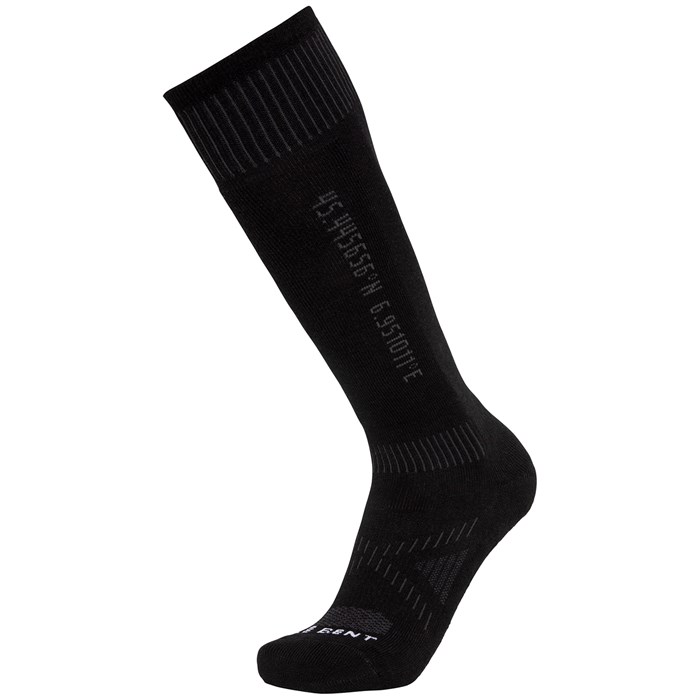
Materials: Rayon from Bamboo 46%, Merino Wool 20%, Nylon 32%, Elastane 2%
Weight: Light
Cushioning: Heel, toe, shin
Pros: Super comfortable blend, doesn’t stink
Cons: Slightly less moisture-resistant
Want the Le Bent material blend without paying extra for the Pro Series? The Le Bent Core Light Snow Sock is a heck of a deal—it’s comfortable, moisture-wicking, and stench-resistant (we’re even guilty of wearing them a couple days in a row with no issue). The bamboo/merino blend is super soft, and everyone who tried this sock rated it highly. Again, the rayon from bamboo doesn’t wick sweat quite as well as pure synthetics, but we honestly prefer the natural fibers due to comfort. In all but the hottest of spring shredding, the Le Bent Core Ligth Snow Sock is going to serve you super well.
Check Price on EVOCoal Lightweight Snow Sock ($40)
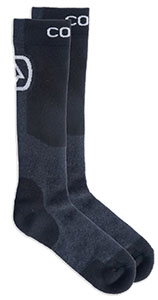
Materials: 50% Merino, 30% Nylon, 20% Acrylic
Weight: Light
Cushioning: Heel, toe, shin
Pros: Fewer seams for a more uniform style
Cons: Less play than other socks
If you’re looking for a no-nonsense sock with fewer seams yet built to keep you in comfort, we enjoyed the simplicity of the Coal Lightweight Snow Sock. It has extra padding where needed, which is important but has no extra bells and whistles. It harkens back to a day when socks were socks and we didn’t need any trademarked features.
The sock is still made of 50% merino, so it’ll keep you warm and dry like the rest of them, yet unlike most others, there isn’t any lycra inside to stretch. So it’s a sock that works like a sock. As such, it may be prone to stretching out if you don’t take care of it, so be cautious of getting one that doesn’t fit right or it might move out of place. But we appreciated how it does what it’s supposed to do and it still rides well and feels comfortable enough for us to give it our approval.
Check Price on Backcountry
A few of our favorite snowboard socks, both for men and women. Photo: Steve Andrews/The Inertia
Best Snowboard Socks Comparison Table
| Model | Price | Materials | Weight | Cushioning |
| Darn Tough Function X Midweight | $32 | 59% Merino, 38% Nylon, 3% Lycra | Medium | Underfoot, Heel |
| Evo Medium Cushion Snow Sock | $20 | 77% Polyester, 18% Polyamide, 5% Elastane | Medium | Heel, Toe |
| Smartwool Full Cushion Snowboard Sock | $29 | 66% merino, 32% nylon, 2% elastane | Heavy | Full |
| Le Bent Xavier De La Rue Pro Series | $37 | 41% Nylon, 34% Rayon from Bamboo, 23% Merino Wool, 3% Elastane | Light | Targeted |
| ThirtyTwo Coolmax | $21 | 41.5% Coolmax, 41.5% cotton, 15% nylon, 2% spandex | Medium | Arch, custom for boot fit |
| Burton Performance Sock | $32 | 38% Nylon 30% merino, 30% acrylic, 2% elastane | Medium | Targeted |
| Icebreaker Ski+ Medium | $31 | 53% merino, 45% nylon, 2% lycra | Medium | Targeted |
| Darn Tough Outer Limits | $29 | 55% nylon, 41% merino, 4% lycra | Light | Shins |
| Burton [AK] Endurance Socks | $37 | 63% Polyamide, 22% Polyester, 10% Wool, 5% Elastane | Light | Targeted |
| Icebreaker Ski+ Light | $31 | 55% merino, 42% nylon, 3% lycra | Light | Targeted |
| Smartwool Targeted Cushion Snowboard Sock | $28 | 66% merino, 32% nylon, 2% elastane | Medium | Targeted |
| Le Bent Core Light Snow Sock | $32 | Rayon from Bamboo 46%, Merino Wool 20%, Nylon 32%, Elastane 2% | Light | Targeted |
| Coal Lightweight Sock | $40 | 50% Merino, 30% nylon, 20% acrylic | Light | Heel, toe, shin |
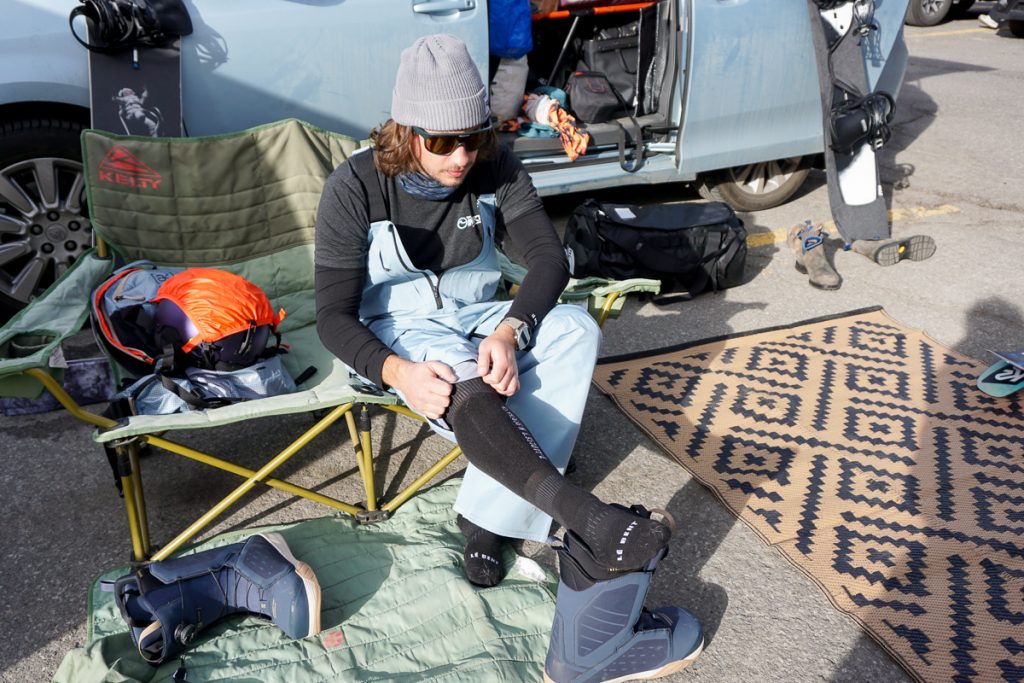
The right socks can make all the difference when snowboarding. Photo: Will Sileo//The Inertia
How We Tested Snowboard Socks
Testing socks that are all great is more difficult than it seems. In other categories, it’s easy to find distinctions, but for socks, we really had to look at the small details. In doing so, we truly found that it’s the little differences that set socks apart from one another. With this in mind, we did our best to highlight these distinctions and speak to what makes each pair of socks better (or worse) for unique conditions and riding styles.
Steve Andrews is our lead tester on snowboard socks. As a snowboarder of over 25 years and a majority of that as a bit of a dirtbag, he had to find out the hard way that good socks can be a huge game changer in the riding experience, and are not worth skimping on. Back in the day, there weren’t too many performance-oriented snowboard socks, and riding in cotton resulted in a wet, stinky mess where boots would get soaked through with sweat and feet would wrinkle up from saturation.
Nathan Lemin also took on snowboard sock testing. A lifelong rider and gigantic sock snob, Lemin is a huge advocate for prioritizing contact points while on adventures. Happy feet make for fun adventures, and snowboard socks are no place to skimp.
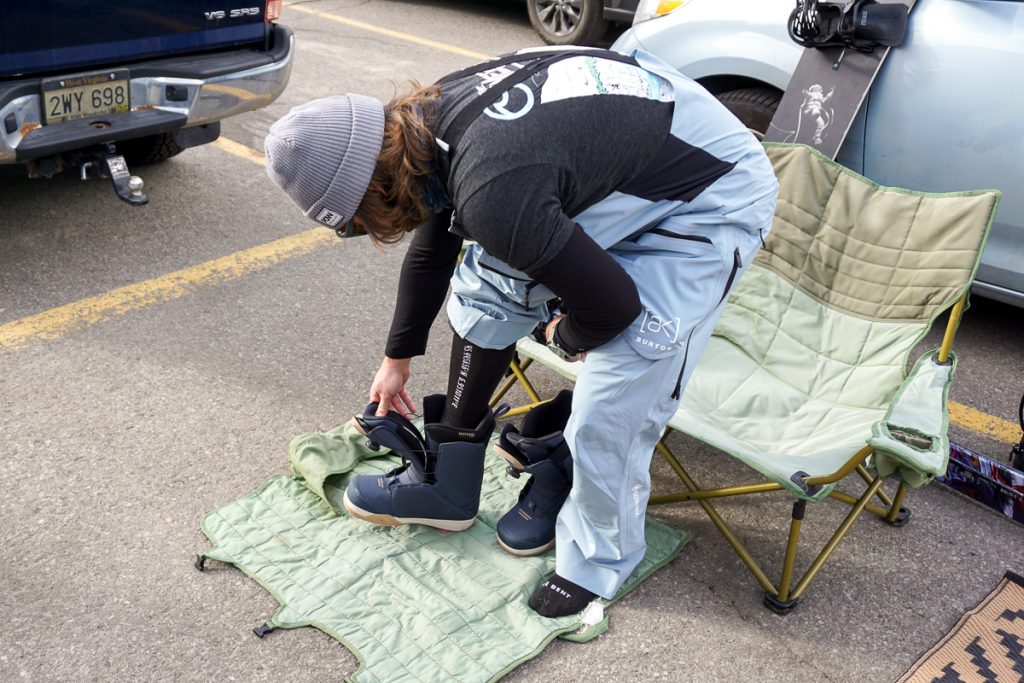
The right snowboard sock material prevents rubbing, blisters, and discomfort. Photo: Will Sileo//The Inertia
Now, with so many great snowboard socks available, the tide has turned and feet have the ability to ride all day in comfort and with precise movement. This is a win for everyone – however, when trying to review the gear, it can become a nit-picky job to find the differences. The main questions we posed were:
Do the socks bunch up? This will result in discomfort and potential issues while riding if the socks begin to fold on themselves, slide down the calf, etc.
Do our feet feel wet/cold? This is no good, no matter which way you cut it.
Can we feel the boot liner inside? And does it rub and leave chafing or blisters? Snowboard socks should be sufficiently padded such that this isn’t an issue.
Can we notice the seams? We want to feel the beauty of riding, not where the seams are.
After many days out in the coastal PNW mountains in a wetter-than-usual El Niño year, the results are in, and the tally has been made. The list above is the best of what we found and will be riding on for the remainder of the season and beyond. if any socks start to show excessive wear in certain spots, we will update this page with the results. However, with the socks listed, we can confidently say: so far, so good.

The Burton Performance Midweight sock was a top choice with our lady testers. Photo: Steve Andrews/The Inertia
Snowboard Socks Buyer’s Guide
Choosing the right snowboard sock for your style may seem daunting, with so many good options available. However, using the criteria in this guide, your decision will hopefully be a tad easier.
Thickness: When it comes to snowboard socks, thickness is a game-changer. Lighter socks offer a better feel, which can be great for those mild days or for riders who want maximum connection with their board. On the flip side, thicker socks provide extra warmth and are a boon for those chilly days on the slopes. But too thick can affect the fit of your boots, so balance is key. Aim for a thickness that keeps you cozy without cramping your style (or your toes!). The Darn Tough Function X Midweight is midweight without being too heavy.
Cushioning: Cushioning in snowboard socks works as a subtle shock absorber. Extra padding on the shin, heel, and underfoot areas can really enhance comfort, especially on those long bell-to-bell days. Look for strategically placed cushioning that aligns with pressure points in your snowboard boots. This feature is not just about comfort; it’s about endurance and performance, helping you stay out longer and ride harder. The Le Bent Xavier De La Rue Pro Series featured our favorite cushioning blend.
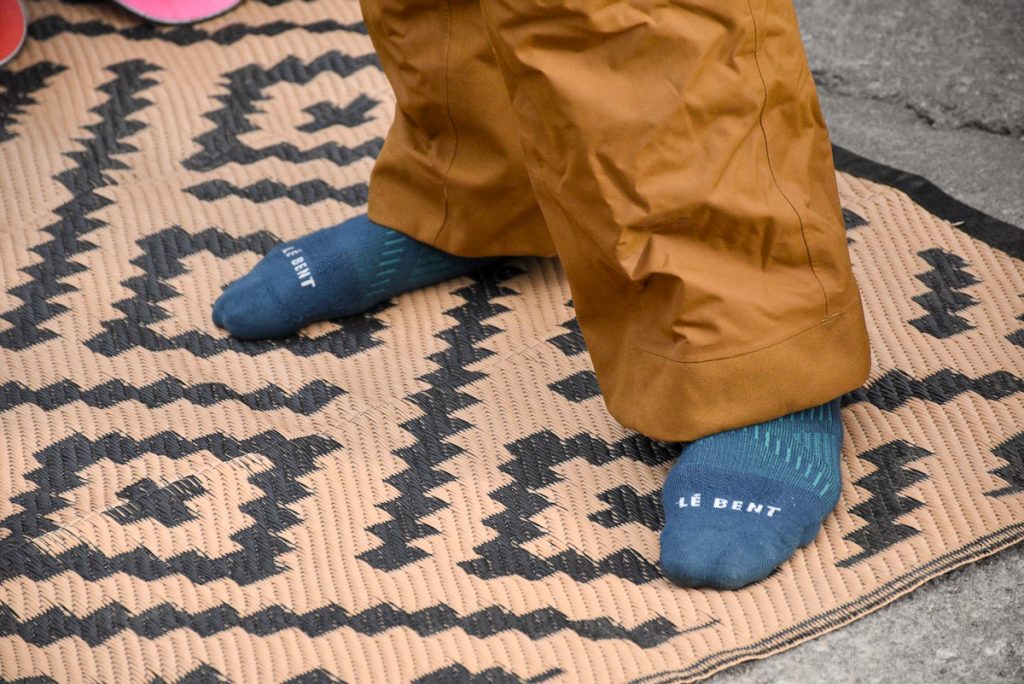
Targeted cushioning works perfectly for snowboarding. Photo: Nick Bruckbauer//The Inertia
Materials: The fabric of your snowboard socks is the main distinction between different socks. Merino wool is a top pick for its magical blend of warmth, moisture-wicking, and odor resistance. For those looking for a vegan or less expensive option, synthetic blends (like polyester and nylon) are your go-to. They dry quickly and are super durable. Most socks mix materials, giving you the best of both worlds. The right material will keep your feet dry, warm, and happy. Something natural like Le Bent Core Light Snow Sock tends to feel more comfortable on the feet.
Seams: Ever had a tiny pebble in your shoe? That’s what an ill-placed seam in a snowboard sock can feel like. Look for socks with minimal and strategically placed seams to avoid chafing and discomfort. Flat seams are ideal as they reduce bulk and the likelihood of irritation. This might seem like a small detail, but trust us, your feet will thank you after a long day of riding.
Breathability: This is crucial for comfort and foot health. A breathable sock helps to regulate temperature and moisture, keeping feet dry and comfortable throughout the day. Materials like Merino wool naturally excel in this, but many synthetic blends are designed for high breathability too. It’s all about avoiding that clammy feeling that can lead to cold feet or even blisters. For a midweight sock, the Evo Medium Cushion Snow Sock is surprisingly breathable.

For everyone who loves the Wu-Tang Clan, Stance has you and your calf covered. Photo: Steve Andrews/The Inertia
Arch and Ankle Support: Some snowboard socks come with added support in the arch and ankle areas. This feature can enhance fit, reduce foot fatigue, and provide stability during those long, active days on the mountain. It’s especially beneficial for riders who demand a bit more from their gear during high-intensity snowboarding.
Antimicrobial Properties: Nobody likes stinky feet after a day in the boots. Materials with antimicrobial properties help keep odors at bay, which is a lifesaver on multi-day trips. Merino wool naturally has these properties, but some synthetic socks also have added treatments to keep your feet fresh.
Style and Design: While performance is key, let’s not forget about style! Snowboard socks come in a plethora of designs and colors. Choosing a style that resonates with your personal aesthetic can add an extra layer of enjoyment to your gear setup. After all, looking good is part of feeling good in the mountains.
Return to Top Picks | Return to Comparison Table
Editor’s Note: If you’re looking to build out the rest of your kit, read our reviews on The Best Snowboard Mittens, Best Snowboard Goggles, Best Snowboard Boots, Best Ski and Snowboard Helmets, Best Snowboard Bags and Best Snowboard Brands. For more gear reviews and features on The Inertia, click here.

